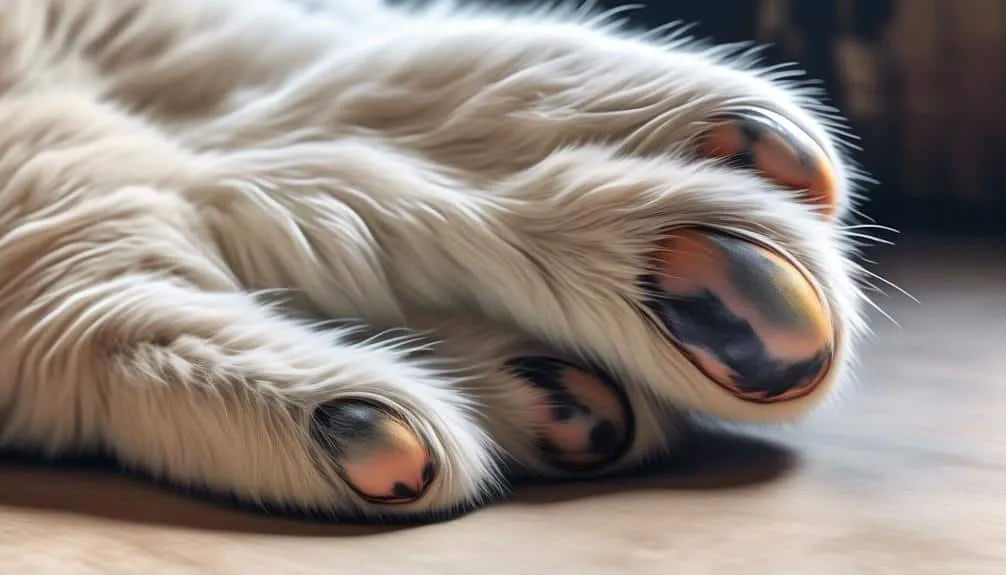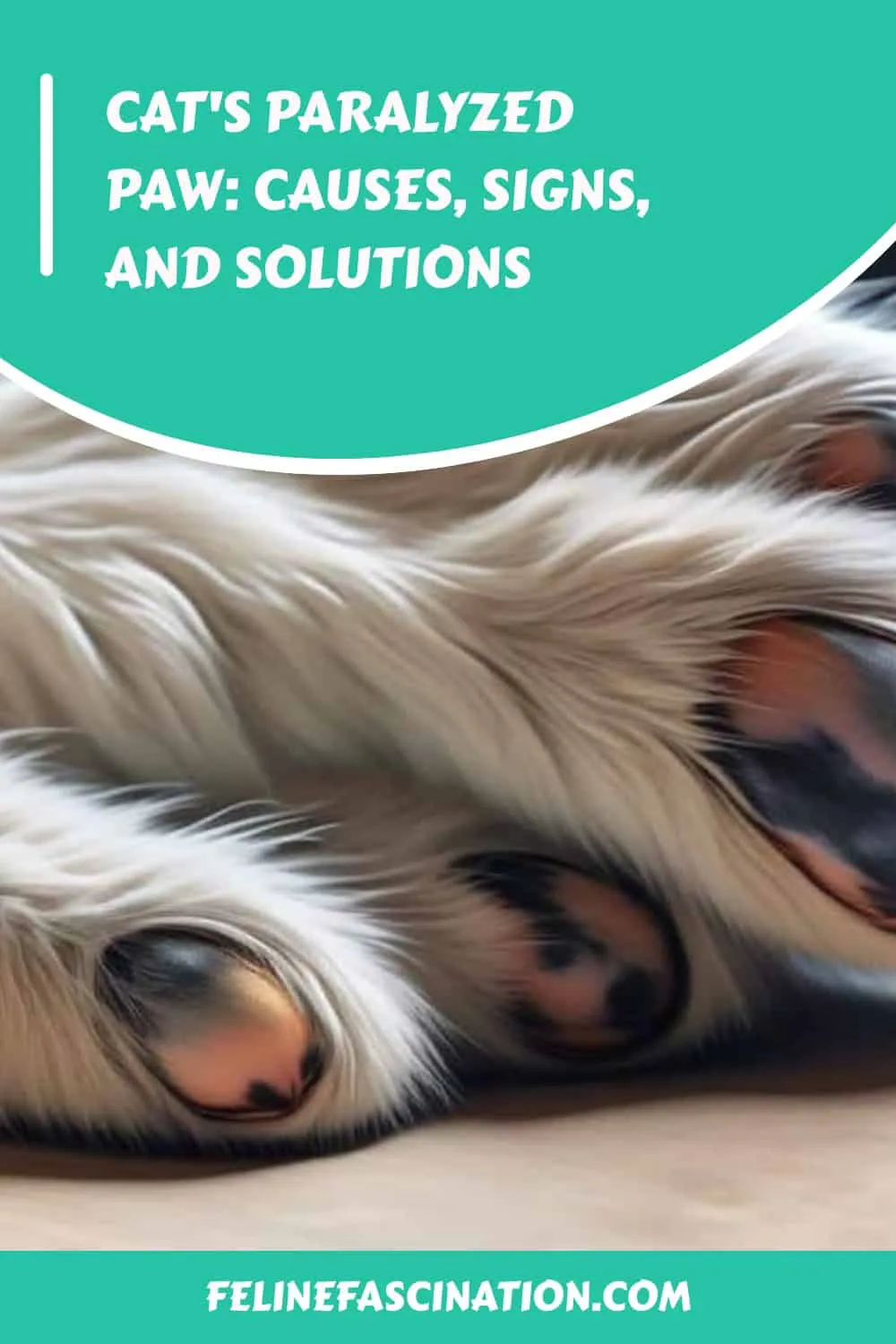The Best Fluffy Pancakes recipe you will fall in love with. Full of tips and tricks to help you make the best pancakes.

Have you ever noticed your cat's paw suddenly lose its strength, leaving them struggling to move? It's as if their once nimble limb has been rendered powerless, like a bird with clipped wings.
In this discussion, we will explore the causes, signs, and solutions for a cat's paralyzed paw, shedding light on this mysterious condition that can affect our feline companions. From traumatic injuries to underlying tumors, there are various factors that can lead to this distressing situation.
But fear not, for there are solutions and treatments available that can help your furry friend regain their mobility. So, let's dive into the world of feline paralysis and discover the path to recovery for our beloved cats.
Key Takeaways
- Radial nerve paralysis in cats can be caused by trauma, bone fractures, tumors, or injuries to the brachial plexus.
- Signs of radial nerve paralysis in cats include weakness or non-weight-bearing front limbs, flexed elbow/wrist/toes, muscle loss, and flaccid limb.
- Diagnosis of radial nerve paralysis is usually based on physical examination and history, with additional tests like X-rays or MRIs sometimes needed.
- Treatment for radial nerve paralysis in cats depends on the underlying cause and may involve rest, pain management, physical therapy, surgery, and rehabilitation exercises. Regular follow-up examinations are necessary for monitoring progress and adjusting the treatment plan.
Overview of Radial Nerve Paralysis
Radial nerve paralysis is a condition characterized by the loss of function in the radial nerve, a major nerve in the forearm of mammals, including cats. The causes of radial nerve paralysis in cats can vary, with trauma being a common factor. Blunt trauma, bone fractures, and penetrating injuries can all lead to paralysis of the radial nerve. Additionally, tumors near the radial nerve or trauma/tumors at the root of the radial nerves can also result in this condition.
Diagnosis is typically based on physical examination and history, with X-rays sometimes needed to identify bone fractures. Treatment options for cats with radial nerve paralysis depend on the underlying cause and may include rest, pain management, physical therapy, surgery, and rehabilitation exercises. Regular follow-up examinations are essential for monitoring progress and adjusting the treatment plan as needed.
Anatomy and Signs in Cats
The anatomy of the radial nerve in cats plays a crucial role in controlling the movement and sensation in the back of their upper limbs. Understanding the signs associated with radial nerve paralysis is essential for identifying and addressing this condition in cats.
Here are some important aspects to consider:
- Nerve conduction: The radial nerve is a peripheral nerve composed of axons and dendrites, which transmit signals between the brain and body parts.
- Muscle loss: Cats with radial nerve paralysis often experience muscle atrophy and decreased muscle tone due to the loss of nerve function.
Recognizing these signs is crucial in diagnosing and treating radial nerve paralysis in cats. By understanding the anatomy and signs associated with this condition, veterinary professionals can provide effective care to serve the needs of their feline patients.
Causes and Diagnosis of Paralysis
Understanding the causes and diagnosing paralysis in cats is crucial for providing effective care to feline patients with radial nerve paralysis.
Radial nerve paralysis in cats can be caused by various factors, including blunt trauma, bone fractures, penetrating traumas, tumors near the radial nerve, and trauma or tumors at the root of the radial nerves.
To diagnose radial nerve paralysis, a thorough physical examination and history are usually conducted. X-rays may be necessary to identify bone fractures, while more advanced techniques such as electrical stimulation devices, MRIs, or ultrasounds may be used for nerve visualization. Nerve conduction studies can also be employed to assess the integrity and functionality of the radial nerve.
Importance of Nerve Anatomy and Paralysis Signs
An understanding of nerve anatomy and recognition of the signs of paralysis are essential for effectively assessing and treating cats with radial nerve paralysis.
Here are five key points to consider regarding the importance of nerve function and the effects of paralysis on daily life:
- Nerve function is crucial for proper movement and sensation in the body.
- Paralysis can significantly impact a cat's ability to perform daily activities and affect their quality of life.
- Recognizing signs of paralysis, such as a weak or non-weight-bearing front limb, muscle loss, and inability to bear weight, is vital for early detection and intervention.
- Nerve anatomy, including the structure and layers of the radial nerve, plays a crucial role in protecting and facilitating nerve signal conduction.
- Understanding the causes and diagnosis of radial nerve paralysis is essential for developing an appropriate treatment plan and improving the cat's chances of recovery.
Causes and Treatment Options
To further explore the causes and treatment options for radial nerve paralysis in cats, let's now shift our focus to understanding the underlying factors that contribute to this condition and the various approaches available for managing it effectively.
Radial nerve paralysis in cats can occur due to various causes, including trauma, nerve compression, inflammation, infection, systemic diseases, and surgical complications. It's important to take preventive measures to avoid paralysis, such as providing a safe environment for your cat and avoiding situations that may result in trauma or injury.
When it comes to treatment, there are alternative therapies that can be considered alongside traditional approaches. These alternative therapies include acupuncture, physical therapy, and the use of herbal supplements. However, it's crucial to consult with a veterinarian to determine the most appropriate treatment plan for your cat's specific condition.
Rest and Pain Management
Rest and pain management are crucial components in the treatment plan for cats with radial nerve paralysis. It's important to provide your cat with the necessary care to ensure their comfort and promote healing.
Here are some key points to consider in managing rest and pain for your cat:
- Rehabilitation techniques: Physical therapy, such as range of motion exercises, can help improve muscle strength and mobility in the affected limb. Hydrotherapy and acupuncture may also be beneficial in promoting recovery.
- Alternative pain relief methods: In addition to traditional pain medications, alternative therapies like herbal supplements, cold laser therapy, and transcutaneous electrical nerve stimulation (TENS) can help alleviate pain and discomfort.
- Regular monitoring and adjustments: It's essential to closely observe your cat's progress and make any necessary adjustments to their treatment plan. This may include changes in pain management strategies or modifications to their rehabilitation exercises.
- Environmental modifications: Creating a safe and comfortable environment for your cat is crucial. Providing soft bedding, easy access to litter boxes, and minimizing obstacles can help prevent further injury and support their recovery.
- Supportive care: Providing your cat with love, attention, and gentle handling can greatly contribute to their overall well-being and aid in their recovery process.
Physical Therapy and Surgery
Physical therapy and surgery are essential treatment options for cats with radial nerve paralysis, offering opportunities for rehabilitation and potential nerve repair.
Physical therapy benefits include improving muscle strength, restoring range of motion, and promoting coordination and function in the affected limb. Rehabilitation exercises, such as passive range of motion exercises and therapeutic massage, can help stimulate nerve regeneration and improve overall mobility. However, it's important to note that physical therapy may not fully restore normal function in all cases.
On the other hand, surgery may be necessary in certain situations, such as when there's nerve entrapment or severe nerve damage. Surgical risks include infection, bleeding, and the possibility of complications during anesthesia.
It's crucial to consult with a veterinary professional to determine the most appropriate treatment approach for your cat's condition.
Follow-up Examinations and Monitoring
After undergoing physical therapy or surgery for radial nerve paralysis, it's imperative to prioritize follow-up examinations and monitoring to ensure the ongoing progress and success of your cat's treatment. Regular check-ups are crucial in assessing the cat's condition and making any necessary adjustments to the treatment plan. Long-term effects and prognosis can also be evaluated during these examinations.
Here are five reasons why follow-up examinations are important:
- Monitoring the cat's overall progress and improvement
- Assessing the effectiveness of the treatment and making any necessary modifications
- Identifying any potential complications or side effects
- Monitoring the cat's pain levels and providing appropriate pain management
- Ensuring that the cat is receiving the necessary support and care for optimal recovery
Conclusion
In conclusion, understanding the causes, signs, and solutions for radial nerve paralysis in cats is crucial for providing the best care for your beloved feline friend.
Whether it's through rest and pain management, physical therapy, or surgery, there are various treatment options available to improve their mobility and quality of life.
By staying informed and working closely with your veterinarian, you can help your cat overcome the challenges of a paralyzed paw and ensure their well-being.










